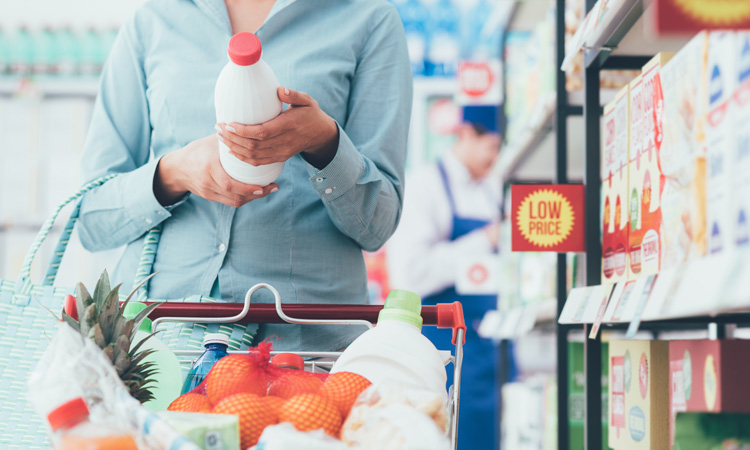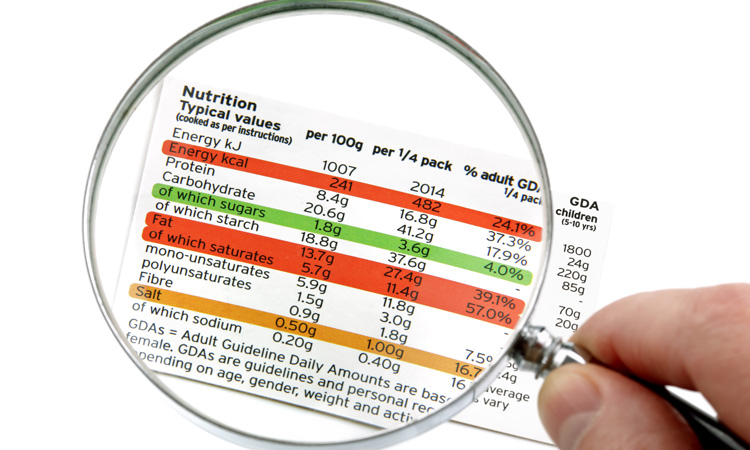Protecting consumers with front of pack labelling
- Like
- Digg
- Del
- Tumblr
- VKontakte
- Buffer
- Love This
- Odnoklassniki
- Meneame
- Blogger
- Amazon
- Yahoo Mail
- Gmail
- AOL
- Newsvine
- HackerNews
- Evernote
- MySpace
- Mail.ru
- Viadeo
- Line
- Comments
- Yummly
- SMS
- Viber
- Telegram
- Subscribe
- Skype
- Facebook Messenger
- Kakao
- LiveJournal
- Yammer
- Edgar
- Fintel
- Mix
- Instapaper
- Copy Link
Posted: 6 March 2020 | Mhairi Brown | No comments yet
Mhairi Brown, Policy and Public Affairs Coordinator for Action on Salt and Action on Sugar, takes a look at how packaging labelling can have adverse effects on public health, and explores what industry should be doing in response.


It’s an uncomfortable reality that poor diet – which includes excess intake of salt, sugar and calories coupled with not enough fibre, fruit and vegetables – is one of the biggest causes of death and disability in the UK and worldwide1. Many everyday food and drink products are high in salt, added sugar and saturated fat and increasingly we are eating outside the home, where portions are bigger and food is generally less healthy than a home cooked meal2.
Serious health conditions linked to poor diet are on the rise, with one in five children aged 11 years and more than a quarter of adults being obese in 20173. Type 2 diabetes is all too common a disease, affecting at least three million of us4 and high blood pressure is also prevalent, which played a role in the more than 42,000 premature deaths from stroke and heart disease that occurred in 20175.
Clearly, something needs to change. A catalogue of actions and policies are required to improve access to and availability of healthier food and drinks; one such policy is front of pack labelling (FOPL). Recommended by the World Health Organization (WHO) as a key tool to help consumers make healthier choices6, FOPL allows consumers to see at a glance the healthfulness of a product, helping to increase their knowledge and attitudes to nutrition and health. FOPL also impacts food and drink companies, making them more aware of the nutrient content of their products which can encourage better product development and reformulation7. Over time, this could help reduce levels of diet-related disease.
Serious health conditions linked to poor diet are on the rise, with one in five children aged 11 years and more than a quarter of adults being obese in 2017.
Since 2013, the UK has had a voluntary front of pack labelling scheme which combines ‘traffic light’ labels, nutrition content per 100g and percentage reference intakes (RI) to highlight levels of calories, fat, saturated fat, sugars and salt8. Designed to comply with EU Regulation No. 1169/2011 on the provision of food information to consumers (EU FIC), the scheme is to be implemented in addition to requirements set out in EU FIC on mandatory back of pack nutrition labelling.
Impact of front of pack labelling
The Department of Health and Social Care (DHSC), who manage the UK’s voluntary policy, estimated that two thirds of food and drink products displayed FOPL in 2016, and more than 80 percent of people used FOPL. Due to the current policy focus on sugar, with the sugar reduction programme and the soft drinks industry levy, it is perhaps unsurprising that DHSC found sugar content was cited by consumers as the most important information on the label9. However, current labelling lists total sugars, not added sugar and the percentage RI for sugar is not based on the updated guidelines that added sugar should only form five percent of our total dietary intake. Given that consumers value knowing how much sugar is in their favourite products, there is still scope to ensure FOPL is as useful to consumers as possible.
Research has shown that FOPL are recognised and used by consumers to find healthier options, with increased use by women and parents, those on higher incomes and those with a higher level of education. Therefore, government must ensure that understanding of FOPL is improved across all socioeconomic groups as all health policies must not exacerbate the health inequality gap. The categories they are most frequently used for are yoghurts, cereals and ready meals10. Green and amber labels are viewed as reassuring, but when trying to make a healthy choice avoiding red labels is more important than choosing a product with more green labels to consumers11.


Nutrition and health claims
Research with consumers has found that health claims e.g. ‘one of your five a day’ or ‘high in fibre’, were the most frequently used shortcuts by shoppers to find a healthier option10. Health claims are currently controlled by EU Regulation No. 1924/2006 on nutrition and health claims made on foods but given the UK’s exit from the EU in January 2020, health claim legislation will now need to be adopted by the UK.
Current labelling lists total sugars, not added sugar and the percentage RI for sugar is not based on the updated guidelines that added sugar should only form five percent of our total dietary intake.
While the UK’s guidelines will likely be aligned with EU legislation, an imminent focus from Public Health England will be food and drink aimed at infants and young children. PHE’s 2019 review12 found that many products marketed for young children carried a nutrition or health claim which did not marry up with the nutrition content of those products. Product names can be misleading, with some suggesting a vegetable base when in drink processed fruit is the main ingredient, providing a source of free sugars and a sweet taste. PHE also found that around three in four fruit juice-based baby drinks were marketed to children under 12 months, despite guidelines stating breast milk, formula and water should be the only drinks between six and 12 months.
Companies that produce products for infants and young children must ensure they support healthy eating guidelines by putting a stop to marketing foods to children under six months of age, as this is the age solid foods should be introduced, removing added salt and sugars, and implementing clear and honest packaging.
The future of front of pack labelling
The UK’s exit from the EU also presents an opportunity to introduce mandatory requirements for food labelling. As part of the government’s Childhood Obesity Plan chapter 213, mandated calorie labelling for the out of home sector in England was proposed, with similar actions being taken in the devolved nations, which would go some way to bringing the sector in line with retail. DHSC are due to release a consultation on the future of FOPL in the UK and it is likely that a mandated approach would be put forward, with strong support from the third sector.
Choosing products with fewer red labels is important for consumers, and this is good news for the UK’s salt reduction programme.
Companies that can get ahead of the game and implement FOPL on all products, in the consistent format consumers are used to, can avoid negative push back if they are subject to mandated measures. Mandated warning labelling are currently in place in Chile, Peru and Mexico, where products with excess levels of salt, sugar and saturated fat (caffeine and sweetener warning labels are also required in Mexico) are subject to these labels on front of pack. Other countries in the region are due to adopt these labels, including Brazil and Uruguay, and if an evaluation of these measures proves successful in improving the food environment then it is possible that this would be adopted more globally. This could ensure compliance from the food industry with PHE’s voluntary reformulation programmes, which have so far had mixed progress.
Action on Salt’s position
When Action on Salt first set up in 1990’s, front of pack labelling was a rarity but in the lead up to the issue of voluntary guidance in 2014, we started to see an increase and our most recent surveys show that upwards of three quarters of products surveyed use FOPL14.
We strongly support mandated FOPL: so many companies currently display them and a mandated requirement would create the necessary level playing field to bring the remaining companies in line. With one in five meals eaten outside of the home in the UK, we also support mandated calorie labelling in the out of home sector but ideally this would then be scaled up to display information on other nutrients too and it is Action on Salt’s position that in the future, menus should display colour coded labelling similar to FOPL to give consumers access to consistent information wherever they choose to eat or drink.
Companies reducing salt levels in high salt products to reduce the number of red labels, and indeed across their whole portfolio, is a key step in reducing the amount of salt we eat in the UK.
Choosing products with fewer red labels is important for consumers, and this is good news for the UK’s salt reduction programme. A large body of evidence shows that excess salt intake leads to high blood pressure, increasing the risk of developing heart disease and stroke15. The majority of the salt we eat comes from salt added to packaged food, with the leading contributors being bread, bacon and ready meals16. Most people do not realise they are eating too much salt for this reason, which would help explain why current salt intake in the UK is around eight grams per day, compared to the recommended limit of six grams per day.
Companies reducing salt levels in high salt products to reduce the number of red labels, and indeed across their whole portfolio, is a key step in reducing the amount of salt we eat in the UK. DHSC estimate that just a one gram reduction in the amount of salt we eat each day would help prevent more than 4000 stroke and heart disease deaths17. Given the huge number of deaths occurring as a result of salt intake, it is conceivable that in the near future, if food industry does not comply with voluntary measures then mandated measures would need to be imposed to protect the health of the next generation.
References
1. Global Burden of Disease Study, 2019 https://www.thelancet.com/article…
2. Department of Health and Social Care, 2018 https://assets.publishing.service.gov.uk/…
3. NHS Digital, 2017 https://digital.nhs.uk/data-and-information/…
4. Diabetes UK, 2019 https://www.diabetes.org.uk/about_us…
5. British Heart Foundation, 2019 https://www.bhf.org.uk/what-we-do…
6. World Health Organization, 2018 http://www.euro.who.int/en/data-and-evidence…
7. World Cancer Research Fund, 2019 https://www.wcrf.org/sites/default/…
8. Department of Health, 2013 https://www.food.gov.uk/sites/default…
9. Department of Health, 2018 https://ec.europa.eu/food/sites/food/…
10. IGD, 2017 https://www.igd.com/charitable-impact/…
11. Scarborough, P., Matthews, A., Eyles, H. et al.Reds are more important than greens: how UK supermarket shoppers use the different information on a traffic light nutrition label in a choice experiment. Int J Behav Nutr Phys Act 12,151 (2015).
12. Public Health England, 2019 https://assets.publishing.service.gov.uk/…
13. HM Government, 2018 https://assets.publishing.service.gov.uk/…
14. Action on Salt http://www.actiononsalt.org.uk/salt-surveys/
15. He Feng J, Li Jiafu, MacGregor Graham A. Effect of longer term modest salt reduction on blood pressure: Cochrane systematic review and meta-analysis of randomised trials BMJ 2013; 346 :f1325
16. Public Health England, 2018 https://assets.publishing.service.gov.uk/…
17. Department of Health, 2012 https://webarchive.nationalarchives.gov.uk/…
About the author
Mhairi Brown is Policy and Public Affairs Coordinator for Action on Salt and Action on Sugar. Mhairi previously worked with the Association for Nutrition where she managed the UK Voluntary Register of Nutritionists, contributed to developing fitness to practice standards for the profession, and where she is now a Trustee. Mhairi is responsible for developing the influence and profile of Action on Salt and Action on Sugar, to gain impact with parliament, policy and decision makers. She also leads the international arm of Action on Salt – World Action on Salt and Health.









